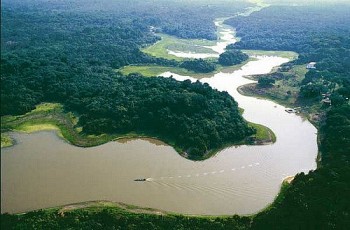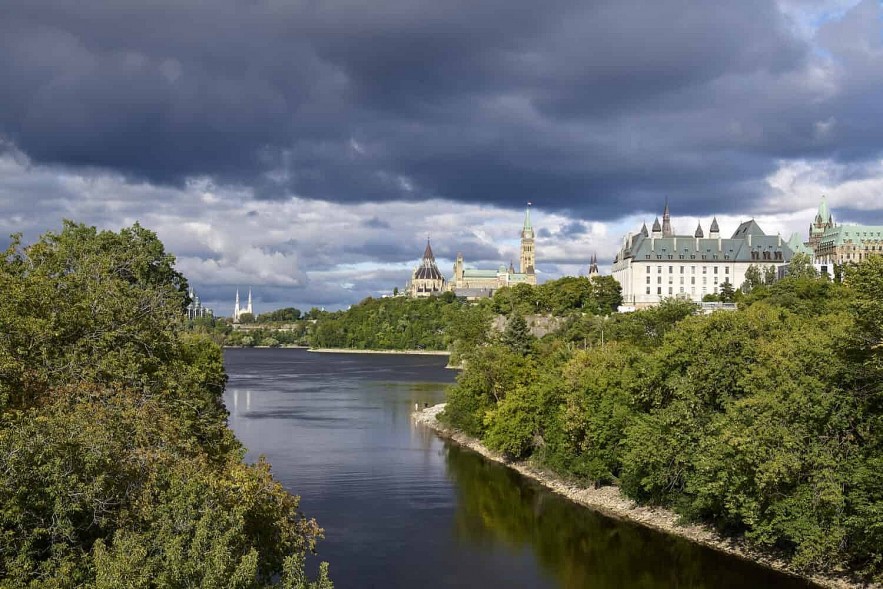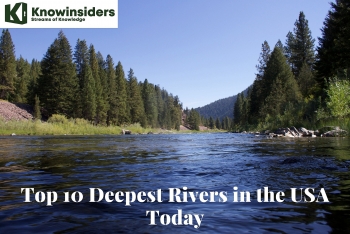Interesting Facts About Ottawa - Deepest River in Canada
 |
| Ottawa River - Deepest River in Canada |
Some of North America's longest rivers can be found in Canada. The St. Lawrence River is also notable for being exceptionally deep. At 250 feet, it's considerably deeper than either the Hudson or the Mississippi. Contrary to popular belief, the St. Lawrence River is not Canada's deepest waterway. Find out where it is, how deep it goes, and more about Canada's deepest river.
Quick Facts: Ottawa River
• The Ottawa River is the deepest in Canada, with a depth of between 318 feet. Ottawa is also the world's fourth deepest river.
• The Ottawa River flows from Lac des Outaouais (Ottawa Lake) to the St. Lawrence River.
• The river flows through the provinces of Quebec and Ontario for a total of about 790 miles.
What is the Deepest River in Canada?
The Ottawa River, which can reach a maximum depth of 318 feet, is the deepest river in Canada. A little more than a mile upriver of the Carillion Hydroelectric Facility, between Chute-a-Blondeau and Greece's Point, the river reaches this significant depth. On the river between Ottawa and Montreal, but closer to Montreal, is this location.
For this river, there are a number of other deeper measures. According to one source, the Ottawa River at Moose Bay is 565 feet deep. According to another source, the river close to the town of Deep River is over 400 feet deep. But according to nautical charts for those areas, the depth of the water there is actually just over 200 feet. It is difficult to imagine that a river channel could get over 200 feet deeper without substantial changes in the area, even though the depth of a river channel can change over time.
The Ottawa River is still by far the deepest river in Canada even at a depth of 318 feet. The St. Lawrence River, which has a depth of about 250 feet, is the second-deepest river. The Yukon River, which is 1,982 miles long, is the longest river in Canada.
| Despite its incredible depth, Canada's deepest river is frequently disregarded. The fact that there are now so many ways to combat it is one of the causes. According to some sources, it is one of the deepest places on earth and is over 500 feet deep. The river, however, reaches a depth of about 318 feet just west of the Carillion Hydroelectric Facility, according to nautical charts. |
 Top 10+ Deepest Rivers in the World - Under Controversy Top 10+ Deepest Rivers in the World - Under Controversy |
History of the Ottawa River
 |
| Ottawa River |
The Algonquin people have a long relationship with the Ottawa River. In actuality, evidence from archeological digs suggests that the Ottawa Valley has been home to the Algonquin people for the past 8,000 years. Fur trading between the French and the Algonquins began in 1603 as a result of the arrival of the Europeans under the leadership of Samuel de Champlain.
The river, which Samuel de Champlain first explored in 1613, bears the name of an extinct tribe of Algonquin Indians. Explorers, fur traders, and missionaries used it as their main route to the upper Great Lakes. Beginning in the early 19th century, lumbering took over as the main activity along the river, and by the middle of the century, it had taken over as the area's main source of income. The Rideau Canal, which connects Lake Ontario and Ottawa, was finished in 1832.
The river no longer serves as a major route for transportation, but it still generates a significant amount of hydroelectric power. Much of Quebec and Ontario receive their electricity from a number of hydroelectric plants, and research is done at the 1944-opened nuclear plant at Chalk River. Pembroke and Ottawa in Ontario, as well as Hull in Quebec, are riverine cities.
After that initial contact, Samuel de Champlain founded a settlement on the St. Lawrence River, traveled to Europe, came back to the region, and further explored the Ottawa River.
From that point forward, the river served as a crucial trade route for Europeans. Over time, certain areas of the river would play a significant role in the lumber industry and eventually serve as the location of several hydroelectric power plants. The Algonquin people still value the river today, and they are still pursuing their land claim against Canada's government.
Geology of Ottawa River
Land that had been buried under the weight of the glacier was made visible by the Laurentide Ice Sheet's retreat some 10,000 years ago. The area now occupied by Lake Nipissing and the Mattawa River served as an outlet for waters from the ancient upper Great Lakes due to its low elevation. To meet the Champlain Sea, an inland extension of the Atlantic Ocean, these waters flowed into the Ottawa Valley. On its way to the sea, the early Ottawa River left behind a fine clay soil in the southern valley. In the otherwise rocky Canadian Shield, it created a lengthy, fertile path.
Animals in the Ottawa River
The deepest river in Canada is home to a huge variety of animals. The following species of animals can be found in and around the river and the nearby wetlands:
Fish inhabiting the river's waters include muskellunge, sturgeon, longnose gar, large and smallmouth bass, yellow perch, walleye, northern pike, and American shad (between 85 and 96 species, depending on the source). The American eel and the river redhorse are two of the fish species at risk that call the watershed home.
The animals that inhabit the Ottawa River's banks in their entirety are much more numerous than this. Along the 790 miles of the river, there are numerous additional species, including some that are endangered.
The river is home to a variety of invertebrates, including over a dozen species of freshwater mussels, crayfish, and snails. Since it first appeared in the 1980s, the invasive zebra mussel has flourished. Zebra mussels clog water pipes in addition to displacing native mussel species from their habitat.
On the Ottawa, water striders, damselflies, dragonflies, and mayflies are frequent aquatic insects.
300 species of birds are supported by the sand flats, marshes, and forests along the river. About half of these species make their most important migration stop in the Ottawa. Canada geese and several species of migratory ducks are especially important to the region between Gatineau and Montebello, Quebec. Numerous bird species breed in its marshes, and the river is home to great blue heron colonies. Eleven raptors, including hawks and eagles, breed in the forests close by.
33 species of reptiles and amphibians, including turtles, salamanders, frogs, and snakes, live in the wetlands along the river. Several turtle species that are threatened with extinction, including the common map turtle, wood turtle, spotted turtle, spiny softshell turtle, stinkpot turtle, and Blanding's turtle, rely on this region as their primary habitat (see also Endangered Animals).
Mink, beaver, muskrat, and otter are among the 53 species of mammals that inhabit riverbanks, and black bears can be found throughout the Ottawa River system near rivers and lakes. Many other mammals, including squirrels, chipmunks, rabbits, raccoons, mice, bats, and white-tailed deer, live in the forest. Wolverines, wolves, lynx, martens, and moose can be found along the river's more northern boreal sections.
Environmental Concerns
Since the Ottawa River's timber trade in the 19th century, pollution has been a problem. Large amounts of sawdust from the sawmills at Chaudière Falls, which are just upstream from Parliament Hill, were dumped into the river, causing a very noticeable blight on the nation's capital.
The Ottawa River pollution was described as "an outrage" by Irish author Oscar Wilde in a public lecture in Ottawa in 1882. He added that "no one has a right to pollute the air and water, which are the common inheritance of all." In his words, "We should leave them to our children as we have received them."
 Top 10 Deepest Rivers in the United States Top 10 Deepest Rivers in the United States In this post, the top 10 of the US' deepest rivers were made according to their maximum depth measured in meters. |
 How Many Rivers Are There In The US: Over 250,000 How Many Rivers Are There In The US: Over 250,000 Do you know how many rivers does the US have? What benefits do rivers bring us? What is the longest and shortest river in the ... |























